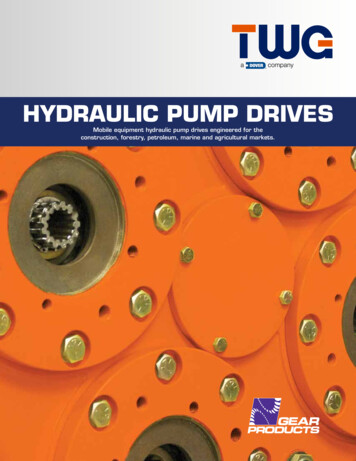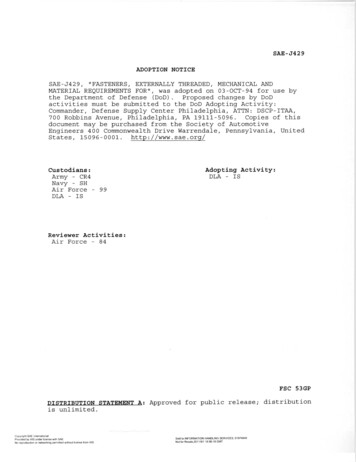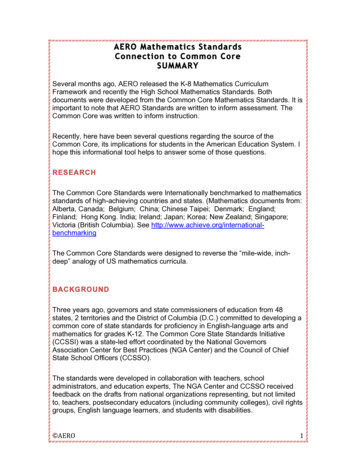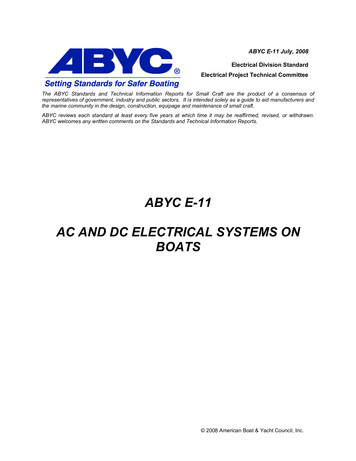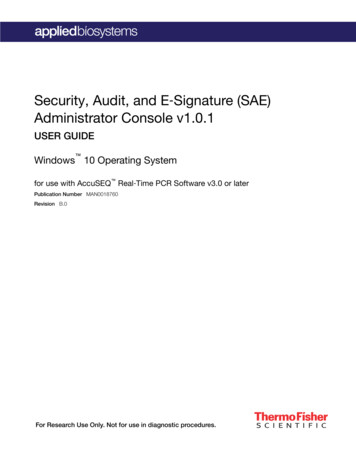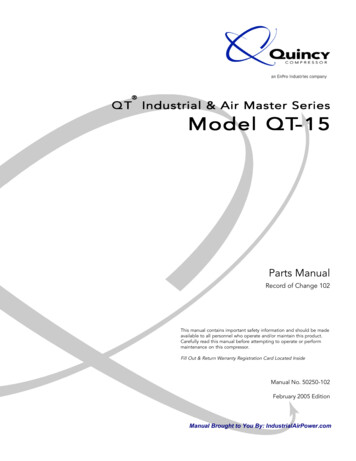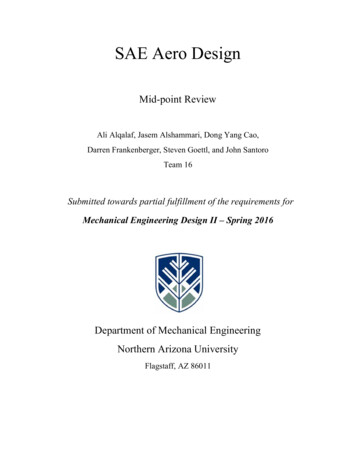
Transcription
SAE Aero DesignMid point ReviewAli Alqalaf, Jasem Alshammari, Dong Yang Cao,Darren Frankenberger, Steven Goettl, and John SantoroTeam 16Submitted towards partial fulfillment of the requirements for Mechanical Engineering Design II – Spring 2016Department of Mechanical EngineeringNorthern Arizona UniversityFlagstaff, AZ 86011
Table of Contents1) Introduction .22) Problem Definition .2 6Need Statement .2Project Goals 2Objectives .3Constraints 3 63) Fabrication .7 14Wing .7 8Fuselage .8 9Tail .9 12Electronics .12 13Difficulties 13 144) Final Design .14 155) Future Modifications 15 166) Bill of Materials .167) Project Plan .178) Conclusions .17 181
1) IntroductionThe SAE Aero Design Competition is an event that is held annually for college students.Teams from all over the country gather and compete in three unique classes: Regular, Micro, andAdvanced. The capstone team is tasked with the design and construction of an airplane thatadheres to the requirements of the Regular class competition. There are many constraints that thecompetition has to make the task complex and difficult. The competition provides a chance forengineering students to learn something about designing and building a product and having funwhile doing it. Most learning has been done in the classroom, so this project gives engineeringstudents the chance to get hands on experience which will help in the future for the engineeringprofession. This report includes the problem definition, details on fabrication of the airplane, afinal design, a bill of materials, and a project plan.2) Problem DefinitionNeed StatementNorthern Arizona University does not have an airplane design to compete in the SAEAero design competition, so the team is tasked with the design and construction of the airplane.Project GoalsThe goal of this project is to design and build an airplane that satisfies all SAE Aero designcompetition requirements and bring it to competition. It is important to aim high when settinggoals, so the team will aim to win the SAE Aero Regular class competition. This project will bevery educational in the manufacturing process, as well as the design aspects that will be neededto complete the airplane. Writing a report and orally presenting the final product is required, sothe team will compile an exceptional report and presentation detailing the design andmanufacturing processes.2
ObjectivesTable 01. ObjectivesObjectiveMeasurementUnit of MeasurementCarry max payloadWeightForce pounds (lb)Carry a payload from point ADistanceFeet (ft)DistanceFeet (ft)to BSmall turning radiusTable 1 contains the objectives that the team has decided are critical for the project.Carrying a max payload is important as the competition adheres to teams that can lift the mostweight. To complete a circuit and get a score in the competition, the payload must be movedfrom one point to another. A small turning radius for the aircraft allows for faster circuitcompletion resulting in a higher score in the competition.Constraints1. Aircraft Dimension RequirementThe dimension must not exceed 175 inches [1].2. Material and Equipment Restrictions for Regular ClassThe use of Fiber – Reinforced plastic (FRP) is not allowed, except in the motor mount,propeller, landing gear and control linkage component. Also, not allowed is the use of rubberbands to make the wing retain to fuselage. Furthermore, any types of gyroscopic or otherstability assistance are not allowed [1].3. Aircraft System RequirementsThe airplane requires the use of a electric single motor, gearboxes, belt drive systems,and propeller shaft extensions are allowed in tow condition (one to one propeller to motor RPMshould be maintained) and the prop(s) must rotate at motor RPM [1]. The battery should have: 63
cell (22.2 volt) Lithium Polymer (Li Poly/Li Po) battery pack. The minimum requirements forLi Po battery are: 3000 mAh, 25c) and homemade batteries are prohibited [1]. A 2015 version1000 watt power limiter from the SAE supplier is required and supplied by Neumoters.com [1].For the radio system the battery should have a minimum capacity of 1000 mAh [1].4. Payload RequirementsFor the payload, the team will focus on the interior dimension and we must follow therequirements in Table 2 [1].Table 02. Length Width Height Tolerance For Payload BayLengthWidthHeightTolerance10.004.00”4.00” 0.125”, 0.000”The airplane should have one or more removable access for the payload bay. The payloadinterior surfaces have to be unbroken and smooth. The payload must also be secured to theairframe, as well as contain payload plates. The only penetrations are allowed in the payload baysurfaces is payload support assembly. The support assembly for the payload must be removableand the bay will never considered as payload [1].5. Other RequirementsThe airplane must take off within a maximum distance of 200 ft. Likewise, the airplanemust land within a maximum distance of 200 ft. Also, the time to complete all aerial tasks mustbe no more than 180 seconds [1].4
6. Quality Function Deployment and House of QualityIn Table 3 below, compared are the regular class design requirements with engineeringrequirements. These comparisons are given a score, then the engineering requirements are rankedby importance. Safety, material and motor were found to be the most important.Table 03. Quality Function DeploymentRegular Class DesignRequirementsAIRCRAFT MaterialMotorGear 90533931309Raw %14%51228674MATERIAL ANDEQUIPMENTRESTRICTIONS FORREGULAR CLASSAIRCRAFT eWeightRank5
In the house of quality, Table 4 below, the team took the engineering requirements from theQuality Function Deployment, Table 3, above to compare them with each other. The comparisonwill help the team know which requirements are related with the others.Table 04. House of Quality6
3) FabricationWingFigure 01. Final Wing DesignFigure 02. Center Piece of Wing7
The wing has a specific rib shape to create the most lift with minimal speeds, which arethe conditions our plane will be flying with in the competition. The design that we decided to gowith is the S1223 airfoil. This design is specific to the SAE competition for lifting a lot of weightwithout moving at high speeds. The team decided to max out the length of the wing to try andcarry a payload of twenty pounds. Our final product for the wing comes out to be 99 inches. Thewing will carry all of the payload weight which gives us the ability to make the fuselage lighterthan normal. The center structure is 3D printed with ABS plastic to ensure the strength that willbe needed to hold the weight of the payload. The final wing design gets the most lift that can beobtained with the speeds that plane will be flying at.FuselageFigure 03. Final Fuselage DesignThe team decided to go with a rectangular prism design instead of using a bar tail or acylindrical shaped fuselage. The team decided to use birch sheets of wood to build the fuselagewith. The team laser cut the pieces and implemented a notched design to help make the8
construction more efficient. The notch design made each piece line up with each other perfectlyjust like a puzzle piece. These notches also allowed for better contact surfaces for the glue toadhere to. This fuselage is hollow which makes the plane a lot less lighter than alternate designsfor a fuselage. The final design is lighter than alternate fuselage designs, which allows the planeto handle carrying more weight for the competition which will result in the team’s success incompetition.TailFigure 04. Tail DesignAbove is the tail design for our airplane on solid works. This twin tail design will beattached by super gluing the wooden parts, while attaching the aluminum pipe by washers ineach side and put a screw through it.9
Figure 05. Tail design viewsThe figure above shows the front, top, and right view for our tail design.Figure 06. Tail design10
The figure above shows that each part of the vertical and horizontal stabilizer moves each way,up, and down, and right and left.Figure 07. Tail ConstructionThe figure above shows the construction of the tail. The right two pieces are thehorizontal stabilizer, and the two left pieces are the vertical stabilizer. As shown six rips are usedfor the horizontal stabilizer and four for the vertical.Figure 08. Tail MonokoteThe figure above shows the processing of applying monokote the stabilizers.11
Figure 09. Finalized Tail ConstructionThe figure above shows the finalized construction of the stabilizers. The stabilizers will beattached to the fuselage.ElectronicsFigure 10. Functional DiagramShown above is the functional diagram for the electrical components of the aircraft. Redwires are positive, and black wires are negative. Blue wires denote servo wires. The battery isconnected to the electronic speed control (ESC), which is then connected to the motor with avariable controller allowing for different power settings. The arming plug is connected to the12
battery as well, providing a killswitch. This is required by competition rules. Also wired to thebattery is the battery eliminator circuit (BEC). Connected to the BEC is the receiver via a servowire. This eliminates the need for a separate battery for the receiver. Configured to the receiverare the servos connected to the different control surfaces. The rudder servo and nose gear servoare connected via a y harness, and one will be reversed giving the proper control to the user.There will be one elevator servo and two aileron servos connected to the receiver as well via ay harness. Finally, the receiver is configured to the transmitter wirelessly via a 2.4 Ghz signal.Figure 11Figure 12Figure 13Shown above are a few examples of the electronics implemented in the final design.Illustrated in Figure 8 is a servo mounted to the wing. Connecting the electronics required a lotof soldering, shown in Figure 9. Figure 10 shows the propeller attached to the motor mounted tothe nose of the fuselage.DifficultiesThe team ran into many obstacles throughout the fabrication of the plane. Most of theobstacles that we came across were simply buying things like nuts, washers, bolts, glue, sticksand balsa sheeting to complete the components in the best manner possible. One of the biggestdifficulties that the team ran into was the monokote that needed to be put on every externalsurface of the plane. The monokote process takes very delicate work. The sheets need to beironed on to each of the contact points of the exterior surfaces on the plane. This process istedious and needs to be done with delicacy in order for the monokote to be able to shrink to atight fit. The monokote must be a tight fit in order for the air to flow as smooth as possible13
preventing turbulence. While heating the monokote with a heat gun to make it shrink, it is veryeasy to put a hole in the surface. The monokote also needed more surface area to stick to than theteam had anticipated. To move past this obstacle with a good final product on the wing,horizontal stabilizer and vertical stabilizer the team glued on balsa sheeting along the edges ofeach of the components. This resulted in much tighter fit monokote which will in the end makethe plane flights go much smoother.4) Final DesignThe final design and fabrication of the aircraft has the dimensions of 99” wingspan by55” fuselage length by 19” tall to the tip of the vertical stabilator. The total combined lineardimensions of the aircraft is 173”. This is just 2” short of the 175” dimension constraint. Theaircraft features heavy duty aluminum tricycle landing gear able to absorb the high stress oflanding with a payload. Attached to the landing gear are 4” tubeless rubber tires on high strengthplastic wheels. The aircraft features unique control surfaces utilizing a stabilator design approachwhich provides more control than traditional control surface designs. Mounted on the front of theaircraft is a 22.2 volt dc motor with a 18” diameter propeller attached to it. The figures belowshow the aircraft after the fabrication phase.Figure 14. Final Design North West Isometric14
Figure 15. Final Design North IsometricFigure 16. Final Design North East Isometric5) Future ModificationsAlthough a final design has been presented, multiple minor modifications need to beaddressed before testing. Currently, the team’s motor has its coil exposed to the air. Duringflight, this exposure could lead to moisture or debris interfering with the motor causing amalfunction. To prevent this from happening, a cowling will be added to cover the motor. Thecowling will be designed and manufactured using rapid prototyping. Secondly, the verticalstabilizers in the current design are subject to a small amount of deflection. To fix this, a smallbar will be added to the vertical stabilizers to achieve more stability and control. Thirdly, thenose gear servo needs adjustment, as a reverse servo is required for the current design. Finally, inthe current design, the aircraft’s center of gravity lies at about a half chord. To achieve balance,15
an aircraft’s center of gravity needs to lie at a quarter chord from the leading edge of the wing.The team will accomplish this by moving internal electrical components towards the front of theairplane’s fuselage. Also, the insertion of payload plates will help the team obtain a moredesirable center of gravity.6) Bill of MaterialsTable 05. Bill of MaterialsTable 5 above shows the bill of materials for the team’s aircraft. The motor, battery,ESC/BEC (Electronic Speed Control/Battery Eliminator Circuit), balsa, and ABS plastic take upthe bulk of the airplane costs. The receiver and servos also add a significant amount of cost.Funds will be received from NAU SAE, specifically for the ABS. The ABS three dimensionalprint is needed for the center of our wing because it must be one solid piece to have the amountof strength that needed to support the weight of the aircraft. The landing gear, motor mount, andaluminum sheeting will all be machined. The arming plug and power limiter are specified SAEcompetition requirements.16
7) Project PlanTable 06. Project PlanTable 6 above details the project plan for the second semester of mechanical engineeringcapstone design. Tasks have been assigned on a biweekly basis in the form of hardware reviews.Weeks one and two consist of fuselage design, tail design, and wing construction. Weeks fourand five include fuselage and tail construction, and landing gear design. Weeks six through nineinvolve the fabrication of the airplane. Weeks ten through twelve consist of testing andmodifying the airplane. Progress will be presented halfway through the semester, while a finalreport will be compiled and presented at the end of the semester. The plan which we areprogressing after the spring break is testing our team aero design and get data feedback and thendoing research and calculation for this project.8) ConclusionsIn conclusion, the Northern Arizona University SAE Aero senior capstone team willdesign and build an aircraft to compete, as representatives of Northern Arizona University, in theSAE Aero design competition. The capstone team has finished the design and build phases of anaircraft that adheres to the SAE Aero competition requirements and constraints. The wing designhas been implemented and has been constructed. The tail design has been implemented and has17
finished fabrication. Final electrical components of the aircraft, such as the motor, propeller,battery, and electronic speed control have been installed. The team has finished the major designand construction of the aircraft, with testing and minor modifications to be accomplished by thenext hardware review. The team has begun detailing the final design and manufacturingprocesses in preparation for the final presentation. Basically our team is trying to do as mucheffort as we can to fixing the error and calibration to reach the significant fit based on SAEAERO design requirement.9) References[1] What When How, “Tail design”, Conventional Tail, T tail, Dual Tail, Triple Tail and TwinTail. Available: what when how.com.[2] National Aeronautics and Space Administration, ”structures and materials”, aircraftbackground, P3 4.[3] P. J. Pritchard, Introduction to Fluid Mechanics 8th Edition. Fox and McDonald. Wiley,2011.[4] M. H. Sadraey, Aircraft design: a systems engineering approach. Hoboken, New Jersey:Wiley, 2012.[5] “Airfoil Tools,” Airfoil Tools. [Online]. Available at: http://airfoiltools.com/. [Accessed:2015].[6] Flight calculations. Ecalc Calc for Airplanes. [Online]. Available at: http://www.ecalc.ch/18
Northern Arizona University does not have an airplane design to compete in the SAE Aero design competition, so the team is tasked with the design and construction of the airplane. Project Goals The goal of this project is to design and build an airplane that satisfies all SAE Aero design . For the payload, the team will focus on the interior .




